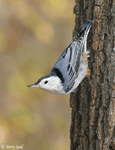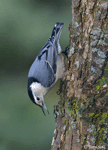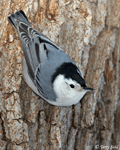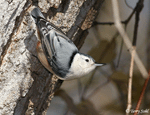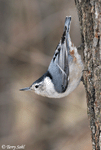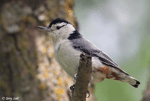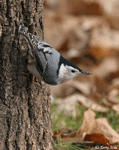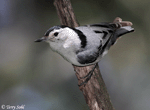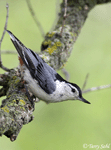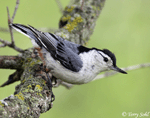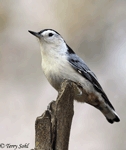| Length: 5 - 6 inches | Wingspan: 9 - 11 inches | Seasonality: All Seasons |
| ID Keys: White face and neck, black head stripe and nape, blue-gray upperparts | ||
 White-breasted
Nuthatches are a very common visitor to home feeders,
often forming mixed flocks with Brown Creepers, Chickadees, and Downy
Woodpeckers during the winter months. White-breasted Nuthatches are often seen foraging upside-down on tree trunks,
as in the photo on the right. They will take seeds and wedge them into
crevices in a tree's bark, using it to hold the food item while they break it
open with their beaks.
White-breasted
Nuthatches are a very common visitor to home feeders,
often forming mixed flocks with Brown Creepers, Chickadees, and Downy
Woodpeckers during the winter months. White-breasted Nuthatches are often seen foraging upside-down on tree trunks,
as in the photo on the right. They will take seeds and wedge them into
crevices in a tree's bark, using it to hold the food item while they break it
open with their beaks.
Habitat: Forests, woodlots, groves, residential areas.
Diet: Mostly insects, also seeds. Eats mostly insects during summer, supplementing with seeds in the winter.
Behavior: White-breasted Nuthatches nest in cavities, and are usually quite territorial towards other nuthatches. They will cache excess food in the cracks and crannies of tree bark for retrieval at a later date.
Nesting: May through July. The nest of a White-breasted Nuthatch is built in a cavity in a tree, and is a cup built of grasses, strips of bark, twigs, and other material. The female usually lays between 5 and 8 eggs, and she alone incubates them, with the male bringing her food during the incubation period. When the eggs hatch, both parents help tend to the young and feed them. The young fledge after about 3 weeks.
Song: White-breasted Nuthatch Call
Migration: Not migratory, usually a permanent resident.
Interactive eBird map: Click here to access an interactive eBird map of White-breasted Nuthatch sightings
Similar Species: Red-breasted Nuthatch, Brown-headed Nuthatch
Conservation Status: The species is very widespread and common, and faces no immanent threats to their populations. Populations are thought to be increasing in many areas, especially as they've become very accustomed to taking advantage of feeders. The IUCN lists the White-breasted Nuthatch as a species of "Least Concern".
Feeders: Will attend feeders for suet, assorted seeds, and peanuts.
Birdhouses: Will use nest boxes of appropriate size
Further Information: 1) USGS Patuxent Bird Identification InfoCenter, White-breasted Nuthatch
2) WhatBird - White-breasted Nuthatch
3) Audubon Guide - White-breasted Nuthatch
Photo Information: April 20th, 2005 - Brandon - Terry Sohl
Additional Photos: Click on the image chips or text links below for additional, higher-resolution White-breasted Nuthatch photos.
| Click on the map below for a higher-resolution view |
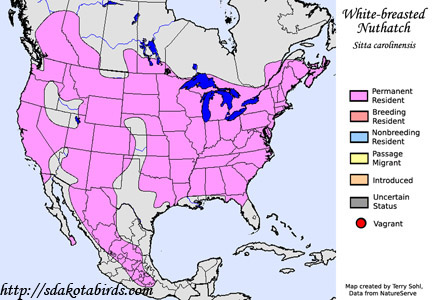 |
| South Dakota Status: Common permanent resident throughout most of South Dakota, where appropriate habitat exists. |
Additional White-breasted Nuthatch Photos
Click for a higher-resolution version of these photos
